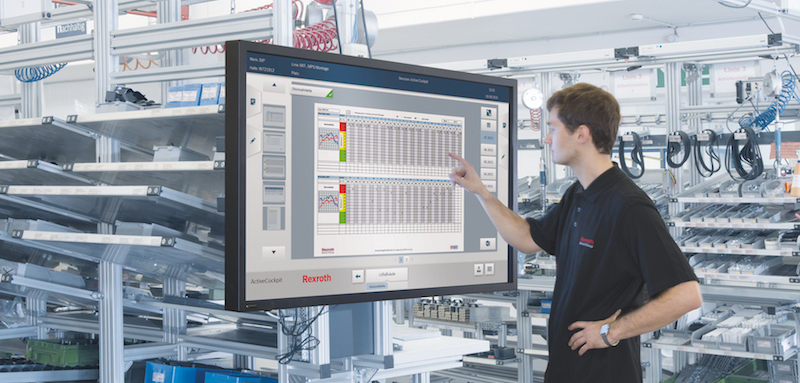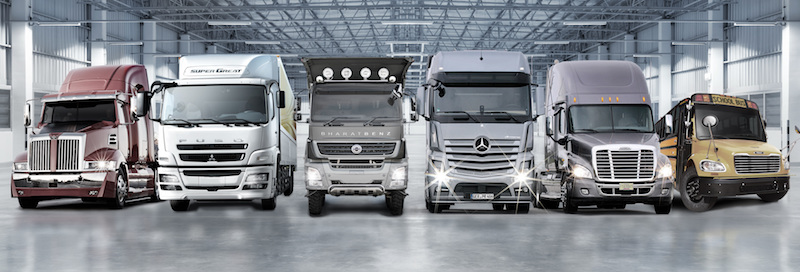The implementation of new digital systems is seeing Industry 4.0 move from concept to reality
 Workers in one area of the Bosch Rexroth plant in Homburg, south-west Germany, effectively ‘clock in’ at the start of their shifts by means of a small Bluetooth tag attached to their belt. However, this is far more than just an electronic update of the old-fashioned punch-machine registration procedure. The sensor that receives the signal from the tag then automatically configures the worker’s designated workstation to suit the particular characteristics of the individual, for example, selecting a font size for the display screen that is customised to their eyesight, as well raising or lowering the table to suit their height.
Workers in one area of the Bosch Rexroth plant in Homburg, south-west Germany, effectively ‘clock in’ at the start of their shifts by means of a small Bluetooth tag attached to their belt. However, this is far more than just an electronic update of the old-fashioned punch-machine registration procedure. The sensor that receives the signal from the tag then automatically configures the worker’s designated workstation to suit the particular characteristics of the individual, for example, selecting a font size for the display screen that is customised to their eyesight, as well raising or lowering the table to suit their height.
Those might seem simple things, but they epitomise in the most practical way what can be made possible when the concept of Industry 4.0 (I4.0) is turned into a day-to-day reality. That is because the workstations that make up the cell, which produces hydraulic valves for use in off-road vehicle applications, have been designed by Bosch Rexroth as an exemplar of the concept in a deliberate attempt to position the company at the forefront of I4.0 implementation and product provision.
The company’s commitment to the concept is confirmed by Dr Matthias Möller, director of the technology and process planning department at the plant. He says the cell, which comprises nine ‘intelligent’ workstations, went live in October 2014 after a one-year implementation project. Since then it has been used intensively and has notched up a series of benchmarked improvements over previous assembly procedures utilised for the products involved. These include: inventory holding being reduced from three days to 1.5 days; cycle times being reduced from 474 seconds to 438 seconds; logistical set-up times dropping from 450 seconds to zero; and an overall production improvement of as much as 20%.
Error-proofing proceduresThere is more to this than just the configuration of the workstations. A whole series of technologies are built into the line whereby a mix of sensors, software control and communication is combined to produce not just efficiency improvements, but also to build-in what is in effect a ‘failsafe’ capability to ensure that only the right products are built at the right time in the right way. All this is accomplished, moreover, across a six different product types in 250 variants which require a total of some 2,000 separate parts.

A key element in that capability, for instance, is a ‘pick-to-light’ system that automatically monitors which of the small parts containers associated with each workstation an operator reaches out for to retrieve components for the assembly they are working on at any particular time. If they attempt to retrieve the wrong parts the system automatically signals their error to them.
Again, while seemingly straightforward, the implications are profound because this simple alarm capability is the essential factor behind the astounding reduction in set-up times that the line enables. Dr Möller explains how: “It was realised with connectivity. The previous production set-up required the removal of all unnecessary components during change over from one product to another. The restocking of lines between product runs took up to 450 seconds per changeover.”
He also explains why: “This logistical task was driven by the quality requirement that only essential components were allowed to be at the workstation, so avoiding the assembly of incorrect components. Now we have the pick-to-light technology combined with RFID identification of each single product. This means that we can leave all components at the line all the time, as it is only the necessary components that are able to be picked by the worker.”
This capability has not, however, been retrofitted to an existing workstation format. The workstations involved are examples of an I4.0 product called ActiveAssist that Bosch Rexroth has developed for sale to the wider market and which is due for commercial release before the end of this year. Apart from the ergonomic customisation and pick-to-light capabilities, the workstations also have a number of other integrated technologies that support interaction between their hardware and software elements and the associated human.
These include overhead cameras and even the use of ultrasound to check the integrity of further actions on the part of the operator, such as nut-tightening, and the tailoring of assembly instructions on the display screen to the operator’s skill and experience levels, so that greater or lesser amounts of text are made available accordingly. Hence an operator will not waste time reading through information and instructions that are irrelevant to them personally.
This is not the only example of the line at Homburg doubling up as both production facility and I4.0 system development site. Just to one side of it stands a large LED screen that, as with the Bluetooth log-in, is far more than just a passive information conduit. Rather it is an example of a system called ActiveCockpit that the company has not only implemented at Homburg but also already made available for purchase.
Intersection of informationThe ActiveCockpit unit is, in effect, the point of intersection of information on production operations on the line itself and higher-end control software such as the factory-wide ERP system, and can be interrogated by touch-screen techniques. As Dr Möller points out, a key factor is that the system supports the real-time updating of the information it displays – it is much more than just, say, a support tool for start-of-shift team meetings. Staff can consult the system during working time to access information relevant to their immediate task or communicate with other systems. That might, for example, include the ability to report any malfunctions immediately to all relevant parties on-site and even accompany the report with a digital photograph of the part involved. As with the display screens on the workstations, the way that information is displayed can also be customised to suit, in this case, not just individual preference but standardised procedures.
Dr Möller says the products made on the line were identified by Bosch Rexroth as ideal for providing a testbed to develop I4.0 techniques that could be diffused throughout the company as a whole. “We wanted to assemble all possible valve types to create a complete valve block on one production line,” he explains. “Our main aim with this first Industry 4.0 line has been to gain the flexibility to enable production to ramp-up and down, and quickly adapt to new product families, and this has proved extremely successful.”
Indeed underlying the whole project is the company’s perception that networking and communications technologies in general have now advanced to the point that they make possible what it regards as the essential enabling factors. These variously include: low-priced sensors; easy-to-use software and hardware; low-priced and virtually limitless computing resource, most obviously via the ‘Cloud’; similarly easily available data storage capacity; distributed intelligence; fast integration and flexible configuration; open standards; virtual representation of real world situations in real-time; digital lifecycle management; and secure networks based on internet techniques.
As such Dr Möller says that Bosch Rexroth believes that the I4.0 concept has moved beyond the realm of the experimental and has become firmly established as a real, usable and more importantly, effective technology. “The technology is available and mature enough to realise I4.0 solutions,” he confirms.
"Now we have the pick-to-light technology combined with RFID identification of each single product. We can leave all components at the line all the time as only the necessary components are able to be picked by the worker" – Dr Mattias Möller, Bosch Rexroth
Upgrading internal information networking systemsAnother automotive production facility, on a far larger scale, at which I4.0 principles have been applied is the Daimler Trucks North America (DTNA) plant in Portland, Oregon, that produces among other trucks the company’s premium Western Star range of vehicles. In a project that was completed within the last 12 months, the plant has had its internal information networking systems upgraded to provide previously unattainable levels of reliability and capability in a project carried jointly by communications specialist Cisco and automated manufacturing technologies provider Rockwell Automation. Consequently, the plant now operates with the aid of widespread use of iPads and even mobile phones on the shopfloor to ensure effective, near real-time information sharing and reporting of manufacturing information.
The basic details are confirmed by Doug Bellin, global senior manager for manufacturing and energy at Cisco, who believes it represents something that can be described as “truly I4.0”. As at a lot of established manufacturing plants, Bellin says the DTNA facility was previously characterised by having a lot of “useful data” out on the shopfloor that was usually “difficult to access”. In fact, he adds candidly, data was effectively “stranded” – isolated in locations such as machine PLCs (programmable logic controllers) – and “not everyone knew where it was or even at times how it was formatted.”
Constant reconfigurationThe implications of this situation were particularly acute in the case of the DTNA Portland plant because of the type of manufacturing carried out there. As Bellin explains, the plant is definitively a “build-to-order” facility with almost every truck coming down the line different from that preceding it. Consequently, operations are characterised by constant “reconfiguration” of production areas to cope with the varying requirements – for instance of chassis size – this entails. This reconfiguration, he continues, is both “physical” and “digital” with the former including not just the need to relocate lineside equipment but also to amend the accompanying paperwork.
As such, a fundamental aim was to transfer as much of the previously physical work involved into the digital realm – an obvious example being abolishing the use of a printed bill-of-materials for each chassis.
Bellin makes it clear that Daimler knew what it wanted when it met with Cisco and Rockwell. The request was simply: “We want to go digital so how do we do it,” he explains. What resulted was a comprehensive plant-wide communications system that has, for example, enabled the company to exploit consistently reliable wireless communications between all parts of the site for staff using either mobile phones or iPad computers. This means that the digital data package accompanying every individual vehicle build is always up to date at every location where it needs to be accessed.
The obvious visible enabling technology for this is numerous access points across the plant that use Cisco’s Aironet hardware to allow users to communicate with the network. But, as Bellin explains, what really represents the I4.0 aspect of this capability is the fact that the network itself is an instance of the Converged Plantwide Ethernet (CPwE) that Cisco and Rockwell have developed between them.
 Evolution of the networking systemEssentially, says Bellin, CPwE is an evolution of the well-established networking system that allows multiple types of communication – for instance, not just control data to and from shopfloor equipment but also, as in this instance, voice and mobile computing traffic – to be carried on a single integrated network.
Evolution of the networking systemEssentially, says Bellin, CPwE is an evolution of the well-established networking system that allows multiple types of communication – for instance, not just control data to and from shopfloor equipment but also, as in this instance, voice and mobile computing traffic – to be carried on a single integrated network.
“All of that data can run on that Ethernet cable without suffering any performance degradation,” he confirms. In fact, the network at DTNA Portland is also carrying video information – a capability that, Bellin notes, allows remote access for specialist staff for troubleshooting problems, as well as more general tracking and tracing capabilities. A single network of this sort is also, he states, considerably less expensive to operate than multiple parallel communication systems.
But, arguably, CPwE also illustrates another important aspect of just what constitutes I4.0 in practice. This, quite simply, is that it is not a set of new technologies but rather the systematic implementation of the latest versions of established techniques to achieve new levels of performance and reliability. It is, as Bellin notes, “evolutionary” change for potentially “revolutionary” effect.
Similarly other immediately visible signs of I4.0 are not necessarily astounding. Walk around the DTNA Portland plant, Bellin says, and you will certainly see “less paper” than you might otherwise. You will also see “more people walking around with a digital device in their hand”. There is also intensive use of RFID tracking of chassis as they move through production. Nevertheless, he states, DTNA is already reporting increased production volumes and it is also intent on implementing much more comprehensive “tracking and tracing” procedures.
According to Dieter Haban, chief information officer for the company: “We needed a new network environment that could support our current and future manufacturing processes and provide reliable, flexible and secure services delivery.” It looks like this has been achieved and DTNA confirms that the project has provided it with the foundation for its future manufacturing strategies.
"All of that data [including control data, voice communications, mobile computing traffic and video information] can run on that Ethernet cable without suffering any performance degradation" – Doug Bellin, Cisco
Big data, smart data, business dataFor a manufacturing facility, the concept of Industry 4.0 is about turning “big data into smart data into business data”. That pithy encapsulation of what is involved is provided by Eugene Smethurst, head of process and automation in the EMEA region for business process design and consultancy operation AECOM. The purpose is the generation of real measurable improvements in efficiency and quality.
In essence, he says, what I4.0 provides is “time competitiveness” and it does this by “digitising lean manufacturing”. In an automotive context what that should make possible ultimately, he suggests, is the abolition of all the non-manufacturing time in the period between a customer placing an order for a car and the completion of the production process. Currently, he says, the former can be 30 or more days, even though the actual time spent on direct manufacturing operations is about two-and-a-half days.
A major means to achieving this will be through what Smethurst terms “digitising the supply chain”. A practical example of this would be provided by the ability to record the precise measurements of all the parts delivered to an OEM so that vehicle assembly could be sequenced according to the closeness to tolerance of the parts involved. Essentially that means individual vehicles could be made with parts that share the same level of variation within tolerance so that they quite literally fit together better than they would otherwise, or that shopfloor processes – he suggests welding as an example - could be amended in real-time on a car-by-car basis to compensate for particularly wide variations within tolerance.
Interoperability is the key The essential technical underpinning for this is defined by Smethurst in a single word: “interoperability”, quite simply the ability of all IT systems and manufacturing equipment to communicate seamlessly and instantaneously. After that, he continues, “you can add the web layer and then you can use the ‘Cloud’.” Right now, though, there is no single set of agreed international standards to define that interoperability. Therefore, Smethurst concedes, just what currently constitutes I4.0 implementation is a matter of opinion. AECOM has, however, been involved with an automotive OEM in the planning for a new vehicle assembly plant on a greenfield site that Smethurst is confident is a valid demonstration of the I4.0 concept. In this instance, the headline achievement involved the reconfiguring of the proposed manufacturing processes to reduce the required internal floor area by 38%.
He indicates that a way was found, for instance, “to use smart technologies drastically to increase process density” – effectively, to allow more people to work in close proximity to the cars in the trim and final area – to allow a significant reduction in the number of stations involved and associated lineside parts delivery and storage requirements. Smethurst says the principles of Industry 4.0 were used “to look at the build sheet and put in a process that works through digitally the actual lineside storage that is needed”. What resulted was a much more comprehensive “digital twin” of the intended area that, in turn, facilitated more intensive simulation and analysis of its intended operations.
Consequently, that has enabled:• Identification of where manual processes could be replaced with automation to increase productivity and quality• Integration of automatic guided vehicles or ‘mobile robots’ capable of quickly reconfiguring parts of the process• The re-design of lineside storage and the logistics of parts delivery• An increase in the number of people at each station from one to four, and work done per square metre, through quadrant working – separating the vehicle into four sections, as well as maintaining quality requirements for A-grade surfaces.


































